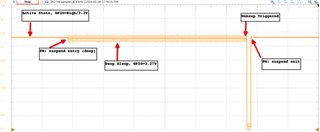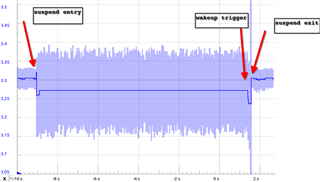Other Parts Discussed in Thread: SK-AM62B-P1
Hello,
we have an issue with GPIO output state not being preserved while in Deep Sleep mode.
This is related to previous questions on the topic:
Our current need and expectation is that any GPIO configured as output is going to keep its state when the system goes into suspend and afterward resume without any glitches.
We are running the latest TI SDK SW 09.02.01.09 on a custom HW.
We are currently measuring GPIO GPMC0_AD2 (as an example), this pin has a 2.2kOhm pull-down on the board (-> it's a strap option).
What is happening is that the Linux software is driving this pin as high, and the pin goes to low as soon as the board gets into suspend (not sure if this is because the pin gets configured as input, because of the pull-down, of if this is actively driven as output). The expectation and the need is that the pin stays to a stable state and that this state is high in suspend.
We did check the pad configuration and everything seems as expected:
# devmem2 0xF4044 w /dev/mem opened. Memory mapped at address 0xffff838c2000. Read at address 0x000F4044 (0xffff838c2044): 0x00050007
Any suggestion?




